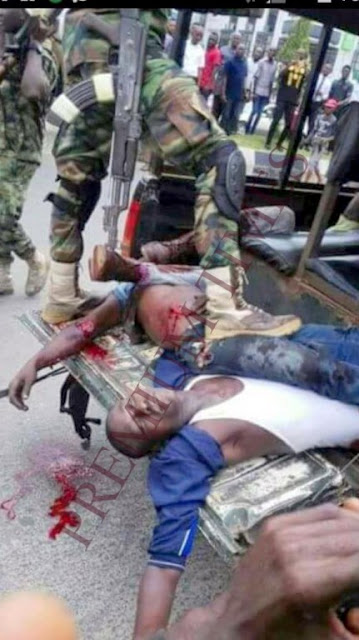A week
after the slaying of pro-Biafra demonstrators in Onitsha, details of how the
mass killing was coordinated by security forces have emerged.
The
following morning, the joint task force moved from the Onitsha Army Barracks to
the rally venue on Nkpor-Umuoji Road only to find a crowd of pro-Biafra
supporters who had been battered the night before by invading soldiers in the
premises of St Edmunds Catholic Primary School.
The
rest is history. The whistleblower said that while other members of the JTF
were minimizing the use of force, soldiers recklessly opened fire at crowds,
shooting at close range, and “wasting people indiscriminately.”
He said
it got to a point where injured pro-Biafra supporters, seeing the countless bodies
of their colleagues on the ground, opened their arms wide, advanced towards the
soldiers screaming that they too should be killed.
Three
military trucks were used to cart away heaps of dead bodies.
The
whistleblower added that in the evening of the same day when everyone thought
the dust had settled, JTF operatives invaded the Nnewi Teaching Hospital and to
the fury of nurses, abducted 12 gunshot victims and seven of their relations
looking after them.
The 19,
including women, were brought before the Commissioner of Police, Hosea Karma.
He claimed that the commissioner accused the 19 of threatening the security of
the state.
He
would however order that the wounded men be returned to the hospital while
their family members be taken away by SARS for interrogation. Human rights
activists familiar with police tactics in Nigeria say that interrogation by
SARS is a euphemism for torture.
Their
whereabouts remain unknown.
As the
news spread that soldiers had invaded the Nnewi Teaching Hospital, gunshot
victims in other hospitals begged their relations to move them to other states.
Among
those moved to Abia State were Chidi Nwigwe, Uchenna Odaa, Ezeaka Ejike, Chima
Anamuasonye, Nwaowe John, Ifeanyi C. Azubuike and Ugochukwu Nnamu. Those moved
to Enugu included Ifeanyi Ogumma and Arinze Aja.
Since
the whistleblower’s account, human rights groups have worked their contacts in
the various security outfits to check out the story. The military police source added that a total of 15 graves were
prepared with some taking as many as 10 bodies while some contained only five.
Blowing the whistle





No comments:
Post a Comment
All rights reserved. This material and any other material on this site may not be reproduced, published, broadcast, written or distributed in full or in part, without written permission from WISEMEN
<===============================================>
WISEMEN is highly honoured to have you as our esteemed reader.
You are encouraged to make comments to any post herein.
However, we shall not be responsible for use of foul language, it is against our professional ethics.
Help build a better Society!